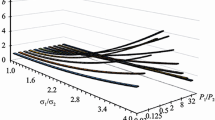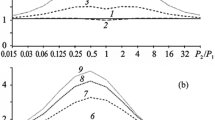Abstract
Radar data from three experiments are analysed. Scatter characteristics of 50 cm wind-generated waves have been investigated with a C-band radar in a large wind-wave tank. Evidence of wave groups in sea clutter from the west coast of Scotland in the Sound of Sleat is also presented. The spectrum of the waves in the sound is narrow-banded and the waves are young, like the wind-wave spectrum in the laboratory. Clutter measurements, collected on the English south coast at Portland, of more ocean-like waves with broad band spectra also suggest the presence of wave groups. Evidence of the presence of wave groups is demonstrated in range-time images, as well as in the Fourier domain. Some ad hoc processing schemes, the normalised variance and binary threshold techniques, were successfully applied to enhance the appearance of the wave groups. The wind waves change frequency with fetch in the wave tank and the downshifting process is investigated using range-frequency maps of the radar data. The waves appear to change frequency in discrete steps that are associated with wave breaking events. The difference in wave period before and after breaking could be measured, and a wave crest was shown to be lost to compensate for the change in period, as expected. Some downshifting could also be measured in the Sound of Sleat. The ratio of wave group frequency and wave frequency is inaccordance with Benjamin-Fier sideband instability theory, as it is for the data measured at Portland.
Similar content being viewed by others
References
Apel, J. (1990): Principles of Ocean Physics. International Geophysics Series, Vol. 38, Academic Press.
Benjamin, T. B. and J. E. Fier (1967): The disintegration of wave trains in deep water. Part 1. Theory. J. Fluid Mech., 27, 417-430.
Blacknell, D. (1994): Comparison of parameter estimators for K-distribution. IEE Proc.-Radar, Sonar Navig., 141(1), 45-52.
Caponi, E. A., B. M. Lake and H. C. Yuen (1999): Hydrodynamic effects in low-grazing angle backscattering from the ocean. IEEE Trans Antennas & Propagat., 47(2), 354-363.
Chapman, R. D. (1992): Meteorological data from the 1991 west coast Scotland experiment. JHU/APL Tech. Report, S1R-92U-007.
Donelan, M., M. S. Longuet-Higgins and J. S. Turner (1972): Periodicity in whitecaps. Nature, 239, 449-451.
Duncan, J. H., H. Qiao, V. Philomin and A. Wenz (1999): Gentle spilling breakers: crest profile evolution. J. Fluid Mech., 379, 191-222.
Fuchs, J. and M. P. Tulin (2000): Experimental scatterer characterisation: the importance and nature of compact scatterers in LGA imaging of the ocean, emphasising microbreakers. Presented RTO SET Symposium, Maryland USA, RTO-MP-60, AC/323(SET)TP/12, 9-1, 9-14.
Fuchs, J., K. D. Ward, M. P. Tulin and R. A. York (1996): Simple techniques to correct VCO nonlinearities in short range FMCW radars. Proc. IEEE MTTS 1996, June, San Fransisco.
Fuchs, J., D. Regas, T. Waseda, S. Welch and M. P. Tulin (1999): Correlation of hydrodynamic features with LGA radar backscatter from breaking waves. IEEE Trans. Geosci. & Remote Sens., 37(5), 2442-2460.
Hasselmann, K. et al. (1973): Measurements of wind-wave growth and swell decay during the Joint North Sea Wave Project (JONSWAP). Dtsch. Hydrogr. Z., 230, 1-95.
Hatori, M. (1984): Nonlinear properties of laboratory wind waves at energy containing frequencies. J. Oceanogr. Soc. Japan, 40, 12-18.
Huang, N. E., S. R. Long and Z. Shen (1996): The mechanism for frequency downshift in non-linear wave evolution. Advances in Applied Mechanics, 32, 59-117.
Ivanov, A. V. and V. E. Gershenzon (1993): Sea surface wave investigations with a stationary pulse Doppler radar. The Air-Sea Interface, Radio and Acoustic Sensing, Turbulence and Wave Dynamics; Proceedings of a Symposium, Marseilles, 709-715.
Lake, B. M. and H. C. Yuen (1978): A new model for non-linear wind waves. Part 1. Physical model and experimental evidence. J. Fluid Mech., 88(1), 33-62.
Lamont-Smith, T. (1997): Radar imaging of strain rate. Radar' 97, IEE Conference Publication No. 449, Edinburgh, 80-84.
Lee, P. H. Y., J. D. Barter, K. L. Beach, C. L. Hindman, B. M. Lake, H. Rungaldier, J. C. Shelton, A. B. Williams, R. Yee and H. C. Yuen (1995): X band microwave backscattering from breaking waves. J. Geophys. Res., 100(C2), 2591-2611.
Longuet-Higgins, M. S. (1984): Statistical properties of wave groups in a random sea state. Phil. Trans. R. Soc. Lond. A, 312, 219-250.
Melville, W. K. (1982): The instability and breaking of deepwater waves. J. Fluid Mech., 115, 165-185.
Philips, O. M. and M. L. Banner (1974): Wave breaking in the presence of wind drift and swell. J. Fluid Mech., 66(4), 625-640.
Smith, M. J., E. M. Poulter and J. A. McGregor (1996): Doppler radar measurements of wave groups and breaking waves. J. Geophys. Res., 101(C6), 14269-14282.
Stevens, C. L., E. M. Poulter, M. J. Smith and J. A. MacGregor (1999): Nonlinear features in wave-resolving microwave radar observations of ocean waves. IEEE J. Oceanic Eng., 24(4), 470-480.
Tulin, M. P. (1996): Breaking of ocean waves and downshifting. p. 177-190. In Waves and Nonlinear Processes in Hydrodynamics, ed. by J. Grue et al., Kluwer Academic Publishers.
Tulin, M. P. and T. Waseda (1999): Laboratory observations of wave group evolution, including breaking effects. J. Fluid Mech., 378, 197-232.
Walsh, E. J., D. W. Hancock, III, D. E. Hines, R. N. Swift and J. F. Scott (1989): An observation of the directional wave spectrum evolution from shore line to fully developed. J. Phys. Oceanogr., 19, 670-690.
Ward, K. D., C. J. Baker and S. Watts (1990): Maritime surveillance radar Part 1: Radar scattering from the ocean surface. IEE Proc. Part F, Radar Signal Process, 137, 51-62.
Werle, B. O. (1995): Sea backscatter, spikes and wave group observations at low grazing angles. IEEE Int. Radar Conf., Alexandria VA, 187-195.
Werle, B. O. (1998): Directional characteristics of sea-wave scattering observed at low-grazing angles. IEEE Trans. Antennas Propagat., 46(1), 41-44.
Young, I. R., W. Rosenthal and F. Ziemer (1985): A three-dimensional analysis of marine radar images for the determination of ocean wave directionality and surface currents. J. Geophys. Res., 90(C1), 1049-1059.
Author information
Authors and Affiliations
Rights and permissions
About this article
Cite this article
Lamont-Smith, T., Fuchs, J. & Tulin, M.P. Radar Investigation of the Structure of Wind Waves. Journal of Oceanography 59, 49–63 (2003). https://doi.org/10.1023/A:1022816422941
Issue Date:
DOI: https://doi.org/10.1023/A:1022816422941




